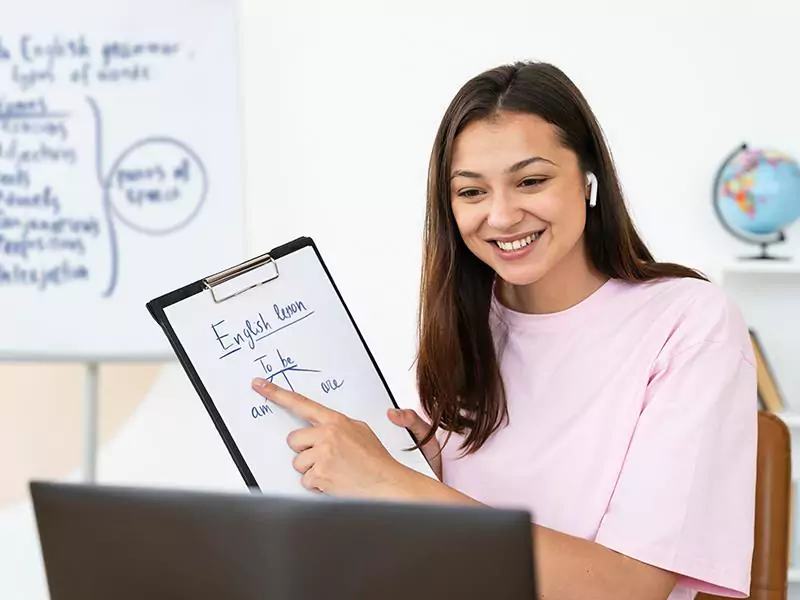Table of Contents
Toggle“The First impression always counts, even through a screen.”
Did you know that within the first few minutes of a virtual class, your teachers and classmates start forming opinions about you — your attitude, confidence, and seriousness? That’s why it’s so important to make a good impression in an online class. A positive first impression creates the foundation for your practical learning experience, helping you build trust and credibility.
Making a good impression isn’t just about looking good—it’s about creating opportunities. It enables you to build and maintain robust relationships with teachers, promotes active participation, and can lead to valuable recommendations, mentorship, and new future opportunities.
Always remember that in an online classroom, your presence matters as much as in a real classroom. So, how can you make a memorable impact when you turn on your camera? Let’s break it down.
5 Ways To Make A Good Impression In An Online Class
Making first impressions count in your online sessions — are you ready? Here are some strategies for students to understand how to be successful in an online class.
1. Technical Expertise and Setup

Be Technically Prepared Before the Class
A glitch in technology can distract from the learning process in online teaching. Being tech-savvy allows you to enjoy a positive learning experience.
- To make a great impression in an online course, make sure all required software is properly installed and up to date.
- All hardware is functioning correctly.
- Test everything ahead of time. Perform a dry run to avoid making last-minute errors.
- Familiarize yourself with the platforms (Zoom, Teams, or any other video conferencing tool you’ll use) – the essential parts of learning management.
- Also, close all the irrelevant browser tabs and apps to prevent notifications or distractions.
Set Up an Optimal Learning Environment
- Choose a quiet, clutter-free location with minimal distractions.
- Ensure good lighting, natural light, or a ring light works well.
- Use a plain or academic-themed virtual background if your surroundings aren’t tidy.
Check Your Tech Gear To Create
- Double-check your internet connection (preferably wired).
- Ensure the mic, webcam, and speakers are functional.
- Use a noise-cancelling microphone or headphones.
- Plugging in your device and having backup options ready can help you avoid sudden shutdowns during class.
Use the Mute Feature Smartly
- Mute yourself when you’re not speaking to avoid background noise. This is an effective practice for students and teachers to create a more positive session.
2. Professionalism and Presence
Start Strong – First Impressions Matter
- Your first interactions set the tone for the entire course, and it was truly a critical first opportunity.
- A great first impression can make students feel confident, inspired, and ready to learn, establishing a connection with their peers and teachers.
Dress Appropriately
- Even though it’s a virtual class, appearance still plays a significant role in making a good first impression.
- Dress as if you were attending a physical classroom.
- Solid colours work better on camera, and your attire should reflect the seriousness of your role as a student.
Be Punctual and Greet Your Teacher and Classmates
- Arriving early (5-10 minutes before class) allows you to test your equipment and settle in.
- It also shows respect for the teacher and classmates as they enter the classroom.
- A warm greeting and making small talk can go a long way in student engagement and building rapport.
Speak to the Camera
- Maintaining eye contact by looking at the webcam instead of the screen supports direct interaction and helps build trust and engagement.
3. Engagement and Communication

Be Proactive and Participate
- Virtual classes require you to participate actively in discussions and activities.
- Don’t shy away from other students to share your thoughts or questions.
- When you engage in class discussions, ask insightful and open-ended questions and respond thoughtfully to peers’ comments. Example: Can you give a real-life example of this topic? How can I apply this knowledge outside of class?
- It demonstrates interest in the subject and helps build a stronger connection with classmates and teachers.
- This also helps in maximizing productivity in online classes.
Break Up Long Lectures
- Keep your attention sharp by focusing on shorter segments of content.
- Whether it’s a video or a lecture, try to break it up into smaller, digestible chunks.
- Participate in polls, quizzes, and breakout room discussions to stay engaged – Key to student engagement!
4. Authenticity and Confidence
Be Yourself
- Your authenticity matters.
- Students connect better with teachers who are genuine and relaxed.
- It helps build trust and rapport.
Speak Clearly and With Passion
- When presenting your ideas, speak clearly and express enthusiasm for the subject.
- Your energy will reflect positively on your attitude and motivate others to engage.
Be Honest and Transparent
- If you don’t know the answer to a question or if you make a mistake, be transparent about it.
- How you handle these moments shows your confidence and willingness to learn, foundational to the learning goals.
5. Empathy and Relationship Building
Show Empathy and Build Relationships
- Be approachable. Show care and understanding when other students share their thoughts or challenges. This encourages a supportive learning environment.
Communicate Regularly
- If the teacher offers feedback or asks questions, ensure you are responsive.
- Regular communication helps create an open line for discussion, making you appear committed to the class.
- If you communicate regularly, students are more likely to trust and collaborate with you.
Keeping up with classroom instructions, discussions, assignments, and deadlines can sometimes feel overwhelming. If you consider do my online class service, it can support you when you need extra help with assignments or participation. By using the right resources, you can stay prepared for your online class and maintain a positive learning experience.
Tips for Teachers to Make a Positive Impression

While this blog focuses on students, online professors also play a crucial role in making online learning successful. Here are some best practices for educators to help frame a positive and lasting impression in virtual classrooms:
- Create a welcoming environment: Greet students personally and encourage them to participate when students enter the classroom.
- Be well-prepared: Understand the course syllabus deeply, have all the materials ready, and ensure your tech setup works smoothly.
- Engage with students: Begin teaching by asking questions, using icebreakers, and engaging in interactive activities to keep the session lively. When students see your enthusiasm, they’re more likely to respond positively.
- Be clear and confident: Speak clearly and maintain eye contact through the webcam.
- Provide timely feedback: Help students understand their progress and areas for improvement. Also, maintain student engagement.
- Maintain professionalism: Dress appropriately, arrive on time, and have a tidy virtual background.
- Use Multiple Ways for Online Students: Deliver The Content. You can offer downloadable course material such as PDFs, short videos, and transcripts.
If you want to make a great impression on your students in your online sessions, use these strategies to Impress Your Online Students and lead them to success. A strong start means a strong finish, giving you numerous opportunities to impress students!
Final Thoughts
Nonetheless, in today’s high-tech world, your first day of virtual class and beyond plays a critical role in setting the tone for your learning experience.
By being technically prepared, understanding your classroom expectations, and engaging authentically, you ensure a positive environment that encourages success.
Whether you’re a student or a teacher, first impressions are key to making a lasting impact. So, make those first moments count! Also, read our other blog on how to get good grades in online classes.
Frequently Asked Questions
To present yourself well, take advantage of early opportunities to impress teachers by being punctual, organized, and respectful. Whether in person or online, a friendly attitude and active participation set a strong tone from the beginning.
What an online course expects from students often includes professionalism, active participation, and timely submissions. To create a good impression, join class sessions on time, engage respectfully in discussions, and stay attentive throughout the lesson.
Begin by being prepared for your virtual class, check your tech setup, know the syllabus, and come ready with questions. Greet the teacher politely, show enthusiasm for the subject, and demonstrate that you're eager and ready to learn.
To create a positive first impression, it's best to avoid passive behaviour. Ask students insightful questions and keep your energy levels high, because when students feel your enthusiasm, they're more likely to respond positively.
Be consistent, communicative, and respectful. Also, engage in conversation with the students. Keeping your camera on when appropriate, responding thoughtfully, and staying organized are excellent ways to make a positive impression in the digital classroom environment.

